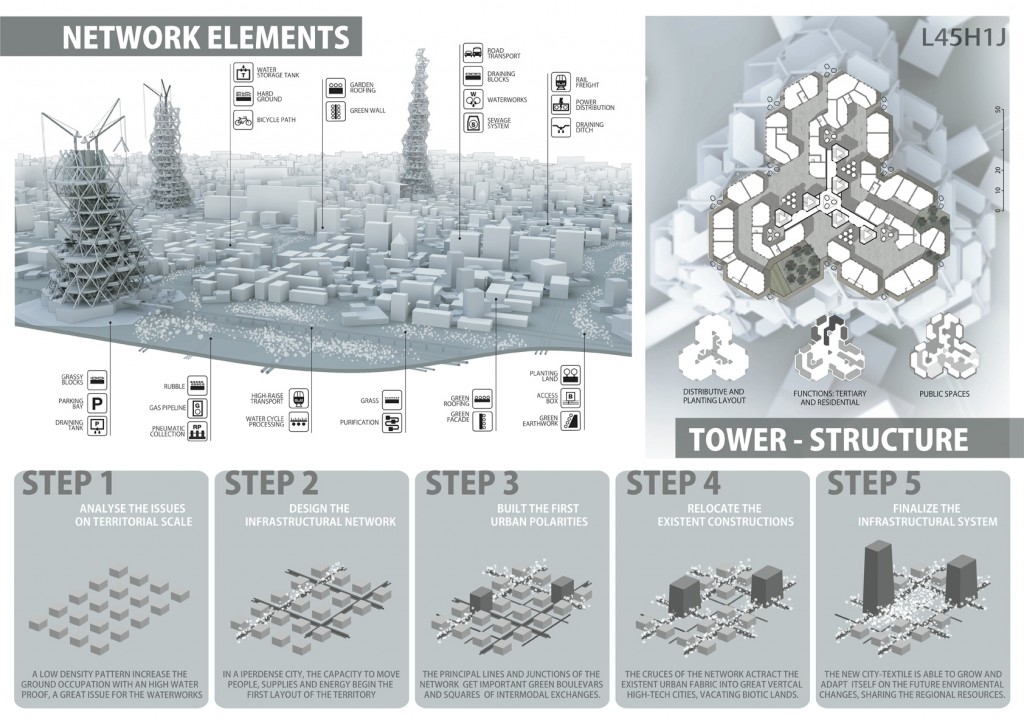Info:
Title: City – Textile - Code: L45H1JContest: Venice / 2011
By: M. Da Re / M. Di Marco
Views: 3601 Likes: 2
Votes:
BJARKE INGELS7 NERI OXMAN8 ELENA MANFERDINI5 MARIA LUDOVICA TRAMONTIN3 BOSTJAN VUGA45.4
City – Textile
A sustainable future – CityVision Venice Venice is not an island. Today we need a system of improvement for Venice that concerns the issues of the entire territory of the lagoon. We need a regional plan of strategies for a new model of a city without boundaries. The planning method will change. The architect has to keep up with the complexity of large-scale issues. He thus becomes a designer of adaptive processes.
We propose a stategy for an urban adaptive design of the territory of Venice.
1) Several critical issues have to be analysed:
- the climate conditions will always change. Global warming is the current rise in the average temperature of Earth’s oceans and atmosphere caused by the human activities. The sea level is raising every year. Probably in the Venice lagoon it will grow one meter high in 2100.
- the increase of population will press on the migration, caused by the climate changes. The town will be dense and chaotic, with serious problems for infrastructures and transportations;
- occidental governments will be even less capable to impose extensive top-down projects. The new participate democracy needs decision-making processes: a bottom-up system;
- in a fragile eco-system the matter of water has a topic role. The regional network flows into the lagoon of Venice, crossing the entire territory. The urban sprawl brakes up the waterworks and the low-density pattern compromises the draining to the water-bearing stratum.
2) We need an adaptive action plan, capable of absorbing changes. We have to re-configurate the urban space.
We propose a new model of unlimited Venice :
- it gets over the traditional idea of town and country, because it involves the concept of scale and boundary, erasing the possibility to adapt itself to unplanned changes. Instead, a connective urban textile will be able to read and design the complexity of the territory. To contrast the sea raising we will defend the lagoon: a realistic solution for the IPCC will be to separate lagoon from sea with a big bank, which will control the tidal energy. Another problem will be the management of the regional draining field. We need an unlimited connective textile, formed by different solutions to the several issues of the territory: a bank in the lagoon, a channel in the town, for example.
- we can’t devise self-sufficiency, because the growth limits should be planned from the beginning, and such a constricted system is destined to collapse. At the contrary, we analyse the landmarks and design a territorial network: a layout of connections to integrate and move people, supplies and energy. Every connective filament is ruled by a hierarchical system (primary filament, secondary filament, etc.).
- we think that the iperdense Venetian territory will be chaotic and variable. What is needed for a good quality of life is an efficient policy about transports and infrastructures. We think that the future Venice will be sustainable if it works like a metamorphic organism. The principal lines and junctions of the network will become important green boulevards and squares of intermodal exchanges. The boulevards will be able to pull down the CO2 emissions, to manage the complex cycle of water, to favor transports and better the lives of people all over the region.
- We can devise two types of architecture: persistent (not permanent) or dynamic. The latter one changes continuosly, being aware of a defined life cycle. Buildings for apartments, commercial constructions or offices are an example of dynamic layout. More importantly, the persistent layout is constituted by durable and adaptive architectures. They have the characteristic to produce culture, and to re-configure and adapt themselves as the climate changes. Therefore, our project is comprised with an enormous building able to resist the changes of the Venetian territory, and absorb the density of the future chaotic city, vacating biotic lands and increasing the green boulevards.
- We propose a tower. Vertical buildings are not such a distant idea by Venice standards. In the town we can simply go up and observe the incredibile number of steeples and bell towers. High buildings work like landmarks in the territory. Our project wants to be a virtuous example of good persistent architecture. Inspired by the projects of Louis Kahn and Buckminster Fuller we have designed a vertical and high-tech city. The tetrahedrical steel structure generates continous spaces. A central technical core serves the tower, in addition to vertical circulation. Public spaces, apartaments and offices are re-configurable. It will be constructed step by step, simplifying the financial and social process.
- This building will never be complete. As soon as a step will be finished, part of the population will be moved into the vertical city. The architectures inside the tower will continually change; dynamic shapes, high-tech or recycle materials, everything will be possible in the future. A complexity of styles, probably meaningless: like a techno-favela.
Info:
Title: City – Textile
Time: 6 giugno 2011
Category: Venice
Views: 3601 Likes: 2
Tags: Buckminster Fuller , Climate Change , Environment , Lagoon , Louis Kahn , M. Da Re , M. Di Marco , Piazza San Marco , Venetian Lagoon , Venice









